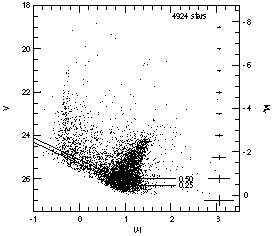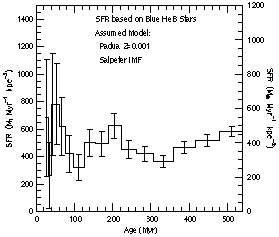


3.4. GR 8
The final galaxy looked at with WFPC2 in this sample is GR 8 (DDO 155, UGC 8091) is a gas-rich dI galaxy with active star formation, on the edge of the LG, at a distance of 2.2 Mpc (Dohm-Palmer et al. 1998). It is slightly more compact and distant than the other galaxies in the Skillman sample, and so crowding was more of a problem in the analysis of the WFPC2 data. Artificial star tests showed the data to be 50% complete to V = 26.3, B = 25.4, and I = 25.2. The CMD shows a well defined population with a very young MS (< 10 Myr), and an RGB as old as several Gyr. A distance estimate, based on the tip of the RGB, was found to be in excellent agreement with the Cepheid determination of µ = 26.75 ± 0.35, or 2.2 Mpc (Tolstoy et al. 1995). There is also evidence for an extended stellar ``halo'' beyond the HI distribution. Based on the MS and BL luminosity function the sfr over the past 500 Myr was estimated to have been fairly constant, with up to 60% variations. The star formation appears to occur in super-association size regions (100-200 pc across), which last ~ 100 Myr. These regions come and go with no obvious pattern, except that they seem to concentrate in the current locations of HI clumps. This suggests that the HI clumps are long lived features that support several star forming events over time.

|

|
Figure 7. Here we show the results for the HST / WFPC2 analysis of GR 8 (Dohm-Palmer et al. 1998). On the left is the V-I, I CMD, 1 orbit exposure time per filter. On the right is the SFH from the MS+BL which best matches the data. See Dohm-Palmer et al. for more details. |